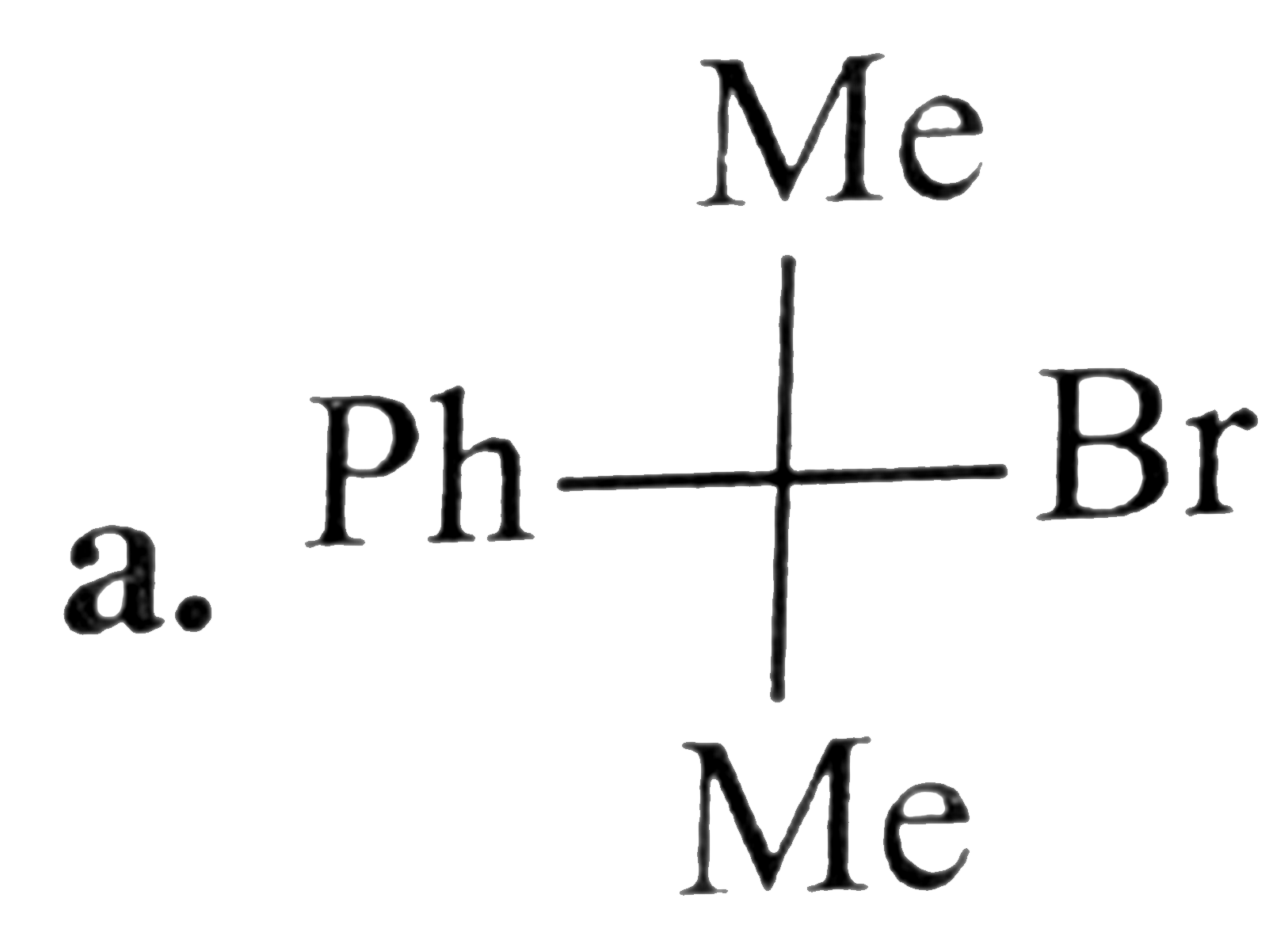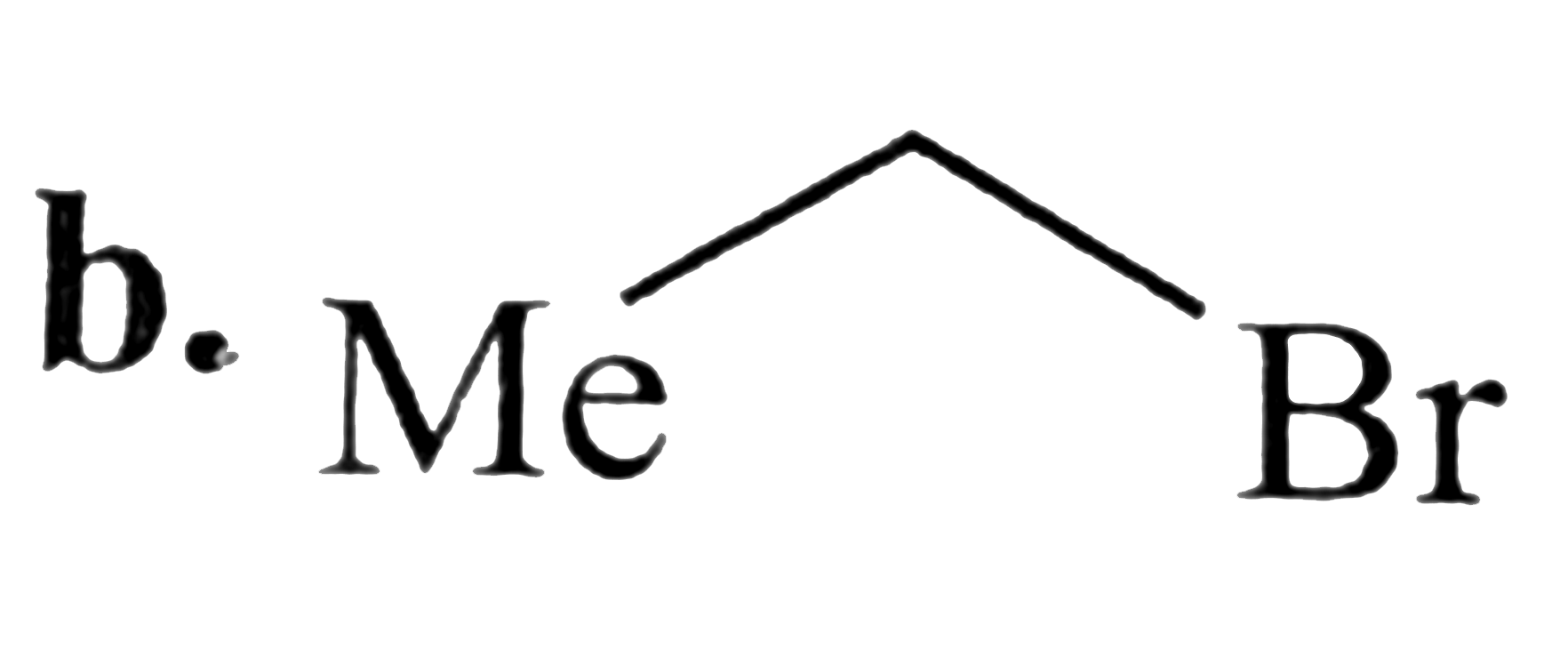SN reaction is given by these compounds, which have a nuclophilic group and a good leaving EWG. It should be stable after leaving with bonding pair of ¯e's and it should have high polarisability.
Nucliphilic aliphatic substituion reaction is mainly of two types SN−1 and SN2.SN−1 mechanism is a two step process. Reaction velocity of SN−1 depends only on the concentration of the subtrate. It proceeds via the formation of carbocation, optically active substrate gives (⊕) and (o−) froms of the product.
In most of the cases, the product usually consists of 5−20% inverted and (95−80%) racemised species. The more stable is the carbocation, the greater is the propotion of racemission. In solvolysis reaction, the more nucleophillic is the solvent, the greater is the proportion of inversion.
Which of the following gives SN1 reaction?


MeBr
All
The correct Answer is:a
To determine which compound gives an SN1 reaction, we need to analyze the stability of the carbocations formed during the reaction. The SN1 mechanism involves the formation of a carbocation intermediate, and the stability of this carbocation is crucial for the reaction to proceed via this pathway.
1. Understanding SN1 Mechanism:
- The SN1 reaction is a two-step process where the first step involves the formation of a carbocation. The stability of this carbocation is key to whether the reaction will proceed via the SN1 mechanism.
2. Identify the Compounds:
- We need to analyze the given compounds (let’s denote them as A, B, and C) to see which one can form a stable carbocation.
3. Analyze Compound A:
- Compound A forms a carbocation that is resonance stabilized due to the presence of a phenyl ring and two methyl groups. The positive charge on the carbocation can be delocalized through resonance, making it highly stable.
- Conclusion: Compound A is likely to undergo an SN1 reaction due to the stability of its carbocation.
4. Analyze Compound B:
- Compound B is a primary alkyl halide. When it forms a carbocation, it results in a primary carbocation, which is not stable.
- Conclusion: Compound B will not undergo an SN1 reaction; instead, it will favor an SN2 reaction.
5. Analyze Compound C:
- Compound C forms a methyl carbocation upon leaving the leaving group. Methyl carbocations are highly unstable.
- Conclusion: Compound C will also not undergo an SN1 reaction and will favor an SN2 mechanism.
6. Final Decision:
- Based on the analysis, only Compound A forms a stable carbocation and is capable of undergoing an SN1 reaction.
Answer:
The compound that gives an SN1 reaction is Compound A.
- The SN1 reaction is a two-step process where the first step involves the formation of a carbocation. The stability of this carbocation is key to whether the reaction will proceed via the SN1 mechanism.
- We need to analyze the given compounds (let’s denote them as A, B, and C) to see which one can form a stable carbocation.
- Compound A forms a carbocation that is resonance stabilized due to the presence of a phenyl ring and two methyl groups. The positive charge on the carbocation can be delocalized through resonance, making it highly stable.
- Conclusion: Compound A is likely to undergo an SN1 reaction due to the stability of its carbocation.
- Compound B is a primary alkyl halide. When it forms a carbocation, it results in a primary carbocation, which is not stable.
- Conclusion: Compound B will not undergo an SN1 reaction; instead, it will favor an SN2 reaction.
- Compound C forms a methyl carbocation upon leaving the leaving group. Methyl carbocations are highly unstable.
- Conclusion: Compound C will also not undergo an SN1 reaction and will favor an SN2 mechanism.
- Based on the analysis, only Compound A forms a stable carbocation and is capable of undergoing an SN1 reaction.
The compound that gives an SN1 reaction is Compound A.
Topper's Solved these Questions
- AROMATIC COMPOUNDS AND ALKYL AND ARYL HALIDES BOOK - CENGAGE CHEMISTRY ENGLISHCHAPTER - AROMATIC COMPOUNDS AND ALKYL AND ARYL HALIDES EXERCISE - Exercises Linked Compreshension Type
11 Videos
- AROMATIC COMPOUNDS AND ALKYL AND ARYL HALIDES BOOK - CENGAGE CHEMISTRY ENGLISHCHAPTER - AROMATIC COMPOUNDS AND ALKYL AND ARYL HALIDES EXERCISE - Exercises Multiple Correct
32 Videos
- AROMATIC COMPOUNDS AND ALKYL AND ARYL HALIDES BOOK - CENGAGE CHEMISTRY ENGLISHCHAPTER - AROMATIC COMPOUNDS AND ALKYL AND ARYL HALIDES EXERCISE - Exercises Concept Application
4 Videos
- APPENDIX INORGANIC VOLUME 2BOOK - CENGAGE CHEMISTRY ENGLISHCHAPTER - APPENDIX INORGANIC VOLUME 2EXERCISE - Short Answer Type
179 Videos
- BIOMOLECULESBOOK - CENGAGE CHEMISTRY ENGLISHCHAPTER - BIOMOLECULESEXERCISE - Exercises Archives (Analytical And Descriptive)
8 Videos
Similar Questions
SN reaction is given by these compounds, which have a nuclophilic group and a good leaving EWG. It should be stable after leaving with bonding pair of ¯e's and it should have high polarisability.
Nucliphilic aliphatic substituion reaction is mainly of two types SN−1 and SN2.SN−1 mechanism is a two step process. Reaction velocity of SN−1 depends only on the concentration of the subtrate. It proceeds via the formation of carbocation, optically active substrate gives (⊕) and (o−) froms of the product.
In most of the cases, the product usually consists of 5−20% inverted and (95−80%) racemised species. The more stable is the carbocation, the greater is the propotion of racemission. In solvolysis reaction, the more nucleophillic is the solvent, the greater is the proportion of inversion.
Which of the following will give SN reaction?
View SolutionSN reaction is given by these compounds, which have a nuclophilic group and a good leaving EWG. It should be stable after leaving with bonding pair of ¯e's and it should have high polarisability.
Nucliphilic aliphatic substituion reaction is mainly of two types SN−1 and SN2.SN−1 mechanism is a two step process. Reaction velocity of SN−1 depends only on the concentration of the subtrate. It proceeds via the formation of carbocation, optically active substrate gives (⊕) and (o−) froms of the product.
In most of the cases, the product usually consists of 5−20% inverted and (95−80%) racemised species. The more stable is the carbocation, the greater is the propotion of racemisation. In solvolysis reaction, the more nucleophillic is the solvent, the greater is the proportion of inversion.
For the reaction

which substrate will give maximum racemismision ?
View SolutionWhich of the following are SN2 reactions ?
View SolutionWhich of the following will give SN2 mechanism?
View SolutionWhich of the following reactions represents SN reaction ?
View SolutionWrite the products of the following SN reactions.
 .
.
View SolutionWhich of the following will not undergo S1N reaction with OH−
View SolutionWhich of the following alkyl halide will undergo SN1 reaction is
View SolutionThe correct order of reactivity of the following bromides towards SN1 reaction is

View SolutionPredicrt the order of reactivity of the following compounds in SN1 and SN2 reactions.

View Solution
